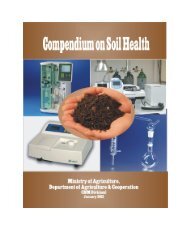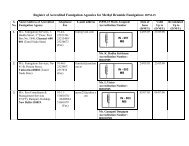canopy management in fruit crops - Department of Agriculture & Co ...
canopy management in fruit crops - Department of Agriculture & Co ...
canopy management in fruit crops - Department of Agriculture & Co ...
Create successful ePaper yourself
Turn your PDF publications into a flip-book with our unique Google optimized e-Paper software.
Prun<strong>in</strong>g Tips<br />
• Prun<strong>in</strong>g should be a regular part <strong>of</strong> orchard <strong>management</strong>.<br />
•<br />
•<br />
•<br />
•<br />
•<br />
The blades should be sterilised after prun<strong>in</strong>g <strong>of</strong> a block or a variety, with a sterilis<strong>in</strong>g solution<br />
<strong>of</strong> 3 % sodium hypochloride.<br />
Heavy prun<strong>in</strong>g should not be carried out <strong>in</strong> hot weather to avoid sun burn <strong>of</strong> branches or<br />
<strong>fruit</strong>s.<br />
In frost prone areas, prun<strong>in</strong>g should not be done on young flush growth, because it is<br />
susceptible to frost damage.<br />
Heavy prun<strong>in</strong>g at wrong time can result <strong>in</strong> excessive vegetative growth.<br />
Prun<strong>in</strong>g dur<strong>in</strong>g budbreak or flower<strong>in</strong>g affects <strong>fruit</strong> load.<br />
• The heavier you prune, the longer time it takes for trees to recover and give <strong>fruit</strong>s.<br />
Lime<br />
Acid lime plants may be tra<strong>in</strong>ed to modified central leader system, with a smooth trunk up<br />
to 75-100cm height from the ground level and 4-5 well spaced and well spread branches,<br />
as scaffold<strong>in</strong>g branches.<br />
• All sprouts appear<strong>in</strong>g on the trunk up to a height <strong>of</strong> 75-100cm should be removed. Similarly<br />
on grown up trees, the water suckers appear<strong>in</strong>g on<br />
ma<strong>in</strong> trunk and scaffold<strong>in</strong>g branches should be removed<br />
promptly.<br />
• Once a young plant is tra<strong>in</strong>ed to a desired shape, it<br />
requires very little prun<strong>in</strong>g. Light prun<strong>in</strong>g may be given<br />
dur<strong>in</strong>g later years.<br />
• Lightly pruned young trees make more development<br />
<strong>of</strong> roots and shoots, produc<strong>in</strong>g <strong>fruit</strong>s earlier that those<br />
pruned heavily. Prun<strong>in</strong>g <strong>of</strong> bear<strong>in</strong>g trees though differs<br />
with variety, chiefly consists <strong>of</strong> removal <strong>of</strong> dead, dried,<br />
diseased, broken and criss cross branches, whose<br />
existence is detrimental to the health <strong>of</strong> trees. Removal<br />
<strong>of</strong> water suckers is also essential.<br />
• Prun<strong>in</strong>g may be done just after harvest<strong>in</strong>g. Soon after Initial tra<strong>in</strong><strong>in</strong>g for better <strong>canopy</strong><br />
prun<strong>in</strong>g, the cut ends may be smeared with Bordeaux paste or Blitox.<br />
Canopy Management <strong>in</strong> Fruit Crops 31

















